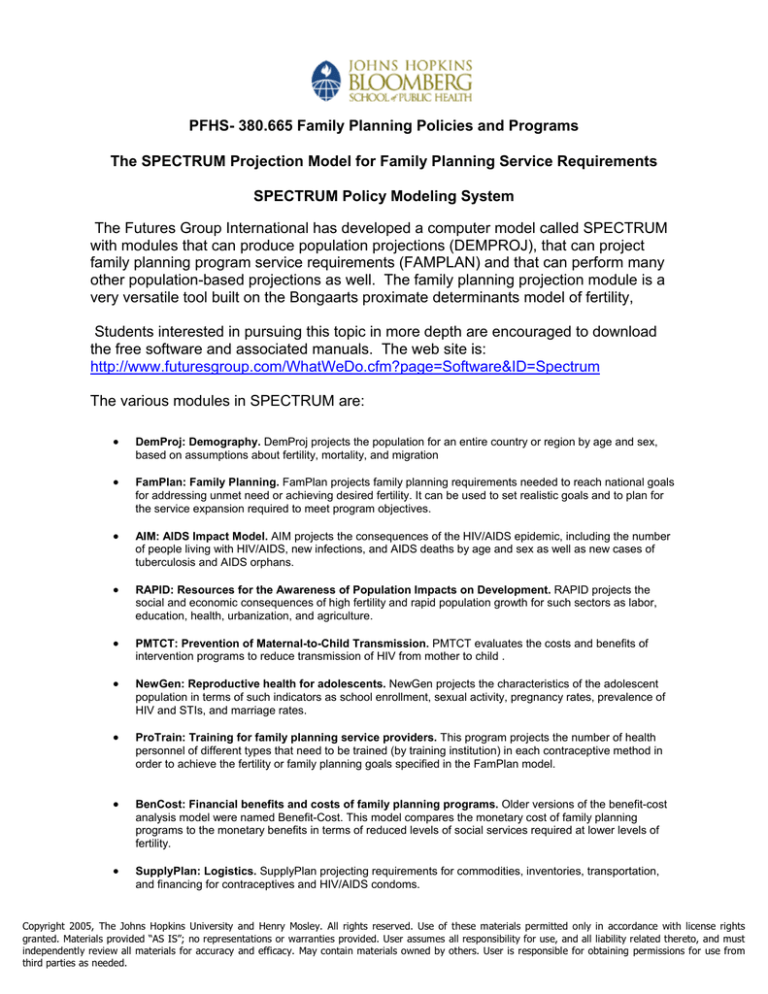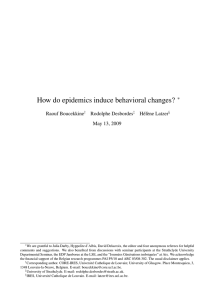
PFHS- 380.665 Family Planning Policies and Programs
The SPECTRUM Projection Model for Family Planning Service Requirements
SPECTRUM Policy Modeling System
The Futures Group International has developed a computer model called SPECTRUM
with modules that can produce population projections (DEMPROJ), that can project
family planning program service requirements (FAMPLAN) and that can perform many
other population-based projections as well. The family planning projection module is a
very versatile tool built on the Bongaarts proximate determinants model of fertility,
Students interested in pursuing this topic in more depth are encouraged to download
the free software and associated manuals. The web site is:
http://www.futuresgroup.com/WhatWeDo.cfm?page=Software&ID=Spectrum
The various modules in SPECTRUM are:
•
DemProj: Demography. DemProj projects the population for an entire country or region by age and sex,
based on assumptions about fertility, mortality, and migration
•
FamPlan: Family Planning. FamPlan projects family planning requirements needed to reach national goals
for addressing unmet need or achieving desired fertility. It can be used to set realistic goals and to plan for
the service expansion required to meet program objectives.
•
AIM: AIDS Impact Model. AIM projects the consequences of the HIV/AIDS epidemic, including the number
of people living with HIV/AIDS, new infections, and AIDS deaths by age and sex as well as new cases of
tuberculosis and AIDS orphans.
•
RAPID: Resources for the Awareness of Population Impacts on Development. RAPID projects the
social and economic consequences of high fertility and rapid population growth for such sectors as labor,
education, health, urbanization, and agriculture.
•
PMTCT: Prevention of Maternal-to-Child Transmission. PMTCT evaluates the costs and benefits of
intervention programs to reduce transmission of HIV from mother to child .
•
NewGen: Reproductive health for adolescents. NewGen projects the characteristics of the adolescent
population in terms of such indicators as school enrollment, sexual activity, pregnancy rates, prevalence of
HIV and STIs, and marriage rates.
•
ProTrain: Training for family planning service providers. This program projects the number of health
personnel of different types that need to be trained (by training institution) in each contraceptive method in
order to achieve the fertility or family planning goals specified in the FamPlan model.
•
BenCost: Financial benefits and costs of family planning programs. Older versions of the benefit-cost
analysis model were named Benefit-Cost. This model compares the monetary cost of family planning
programs to the monetary benefits in terms of reduced levels of social services required at lower levels of
fertility.
•
SupplyPlan: Logistics. SupplyPlan projecting requirements for commodities, inventories, transportation,
and financing for contraceptives and HIV/AIDS condoms.
Copyright 2005, The Johns Hopkins University and Henry Mosley. All rights reserved. Use of these materials permitted only in accordance with license rights
granted. Materials provided “AS IS”; no representations or warranties provided. User assumes all responsibility for use, and all liability related thereto, and must
independently review all materials for accuracy and efficacy. May contain materials owned by others. User is responsible for obtaining permissions for use from
third parties as needed.








